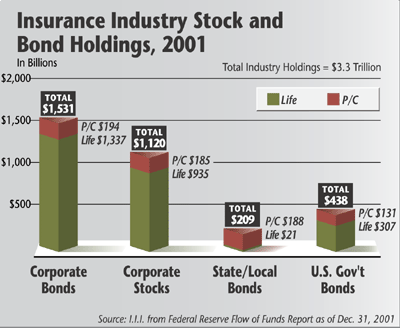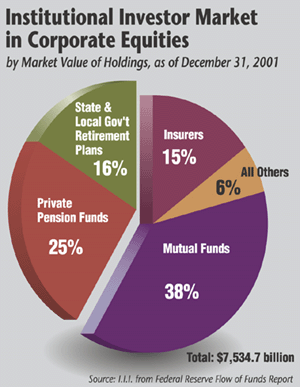What Can Insurers Do To Clean Up The Mess Of CorporateGovernance?
|The $60 billion bankruptcy of Enron last December was theopening act in what has since become one of the greatest and mostserious tragedies in the financial history of the UnitedStates.
|What began as an ethically-challenged relationship between acorrupt energy trader and its shredder-happy auditor has mushroomedinto a crisis that has engulfed the entire market for U.S.equities.
|
Make no mistake, the current crisis in corporategovernance–which has since sucked dozens of publicly tradedcorporations into the ignominy of Chapter 11–has shattered thepublics faith in Wall Street and cost insurers tens-of-billions ofdollars.
|So serious is this breach of faith that U.S. stocks are likelyto finish 2002 down for the third year straight. The last time thathappened was 1939-1941, the years bridging the Great Depression andWorld War II–arguably one of the darkest periods in this countryshistory.
|The stench emanating from the executive suites and boardrooms ofdozens of major U.S. corporations has become too strong to ignore.The blinding greed of too many CEOs–at the expense of theirshareholders, creditors, employees and investors–is a nationalembarrassment, and its cost to the U.S. economy is beyondquantification.
|What can insurers do to help clean up this mess? A lot, as itturns out. And thats good news because its in our industrys ownbest interests and the best interests of policyholders to fix whatswrong in Corporate America as quickly as possible.
| As an industry, we are heavily exposed tothe fallout from the crisis in corporate governance. Life insurersare highly exposed to investment risk. Property-casualty companieshave a mixture of investment risk and insurance risk arising fromdirectors and officers programs sold on the besieged companies, aswell as exposure from entity and fiduciary liability covers.
As an industry, we are heavily exposed tothe fallout from the crisis in corporate governance. Life insurersare highly exposed to investment risk. Property-casualty companieshave a mixture of investment risk and insurance risk arising fromdirectors and officers programs sold on the besieged companies, aswell as exposure from entity and fiduciary liability covers.
In the raucous national debate over corporate governance, ourvoice as an industry can and must be heard.
|Weve earned our place in the debate by virtue of sheer size.Insurers are among the largest institutional investors in theUnited States. In fact, life and non-life insurers in 2001 had acombined total of $3.3 trillion in financial assets undermanagement (see accompanying charts). Of that, 80 percent, or $2.7trillion, was held in the form of corporate equities or corporatedebt.
|Translation–as an industry we have enormous clout, but also anenormous personal financial stake in cleaning up Corporate America.The collapse of Enron alone, for example, produced investmentlosses across the insurance industry totaling $3 billion.
|As an industry we also have a sacred fiduciary responsibility toour policyholders. Does this awesome responsibility, which involvesthe management of funds to pay for everything from a widows annuityto losses stemming from the next terrorist attack, oblige us toaggressively seek the ouster of management that has a bad year ortwo?
|The answer to this is no. What about when management drives acompany into the ground because of self-dealing, deceit and fraud?The answer, once again, is no.
|Institutional investors, including insurers, are required onlyto prudently manage the assets that have been entrusted to them.While this requirement implies the performance of due diligence inadvance of any investment, it does not imply that institutionalinvestors assume what amount to operational duties in corporationswith dysfunctional management.
|Institutional investors can fulfill their fiduciaryresponsibilities by simply selling stock in the troubled company.Indeed, some insurers in recent months appear to have done exactlythis by shifting assets into municipal bonds and asset-backedsecurities to lessen their exposure to equities market risks.
|During ordinary times, punishing poorly performing companies byselling their stock is probably sufficient, but these are notordinary times. A compelling, albeit controversial argument can bemade that insurers should use their clout as major shareholders tohelp purge dysfunctional corporate boards and corporations ofunqualified, incompetent and conflicted directors, officers andmanagers.
|Insurers are not generally known as activist shareholders. Butinstitutional investors in general are becoming increasinglyrestive over the crisis in corporate governance, and some havebegun to take matters into their own hands.
|Consider, for example, the recent actions of the CaliforniaPublic Retirees Retirement System (CalPERS), one of the largestinstitutional investors in the United States and the owner ofroughly three million shares in Enron stock.
|Weeks before Enrons bankruptcy filing in December of last year,the chairman of CalPERS Investment Committee publicly accused theenergy companys senior management of “self-dealing.” His scornextended to the companys board of directors, which he accused ofhaving “failed in its responsibility to monitor the activities ofEnrons corporate officers.”
|The solution, according to CalPERS, was obvious: “[T]heinterests of shareholders are best served by retiring all of thecurrent directors from involvement in Enrons successor entities.”In other wordsthrow the bums out!
|And throw them out they are. Under pressure from pension fundsand labor unions, Enron announced in late May, for example, the“retirement” of two board members who became directors during aperiod when the companys board was waiving conflict-of-interestpolicies that allowed the creation of complex partnerships thatcontributed to the companys bankruptcy.
|One director was the president of a cancer center, the other aretired executive and board member of a major financial servicesfirm itself being sued by Floridas state employee-retirement planfor buying large blocks of Enron stock even as the company stumbledtoward bankruptcy. They are being replaced by an experiencedelectric-utility executive and a risk management expert.
|By forcing out less-qualified board members with seriousconflict-of-interest problems, and replacing them with unconflictedand experienced individuals, activist shareholders certainly seemto be taking steps in the right direction.
|CalPERS and a few other state-employee retirement funds havehistorically not been shy about throwing their weightaround–neither have pension funds managed by labor unions. It couldwell be time for insurers to join them.
|As a united force, insurers could be nearly as influential asretirement funds or pension plans. As a practical matter, however,insurance is a highly fragmented industry that faces a number ofobstacles in presenting a united front on this issue for a varietyof reasons.
|First, insurance is an extremely competitive, state-regulatedbusiness with literally thousands of players, most of them small,regional mutual companies that may feel their voice is too small tobe heard. Investment strategies at large national companies withlarge blocks of voting shares in troubled companies differsignificantly.
|Organizing this disparate group for the purposes of speedingcorporate governance reforms would be a challenge, though tradeassociations could be enlisted to facilitate this task.
|Second, because insurers are generally prohibited by state lawfrom accumulating more than 1 percent of their invested assets insecurities of any single corporation (to limit investment risk andencourage diversification), the influence of any given insurer isautomatically handicapped.
|Third, many insurers will feel that selling a troubled stock isthe necessary and sufficient action required to protect thefinancial interests of the firm and uphold its fiduciaryresponsibility to policyholders.
|Institutional investors, including insurers, are among the fewnon-regulatory organizations that can help bring a speedy end tothe current crisis in corporate governance in America today.
|Some, like CalPERS, have concluded that working actively topurge corporations of self-dealing directors and officers isentirely consistent with their core fiduciary responsibility toprudently manage funds entrusted to them.
|Why shouldnt insurers come to the same conclusion? Relying onthe government to police the boardrooms of America (not to mentioncrooked auditors and heavily conflicted stock analysts) has clearlyfallen well short of the mark.
|If shareholders remain complacent, the likes of Al “Chainsaw”Dunlop of Sunbeam, Ken Lay from Enron, and Worldcom's Bernie Ebberswill be left with even more time to enrich themselves at ourexpense.
|Robert Hartwig, Ph.D., is senior vice president and chiefeconomist at the Insurance Information Institute in New York. Hecan be reached at [email protected].
Reproduced from National Underwriter Property &Casualty/Risk & Benefits Management Edition, June 10, 2002.Copyright 2002 by The National Underwriter Company in the serialpublication. All rights reserved.Copyright in this article as anindependent work may be held by the author.
Want to continue reading?
Become a Free PropertyCasualty360 Digital Reader
Your access to unlimited PropertyCasualty360 content isn’t changing.
Once you are an ALM digital member, you’ll receive:
- All PropertyCasualty360.com news coverage, best practices, and in-depth analysis.
- Educational webcasts, resources from industry leaders, and informative newsletters.
- Other award-winning websites including BenefitsPRO.com and ThinkAdvisor.com.
Already have an account? Sign In
© 2024 ALM Global, LLC, All Rights Reserved. Request academic re-use from www.copyright.com. All other uses, submit a request to [email protected]. For more information visit Asset & Logo Licensing.








